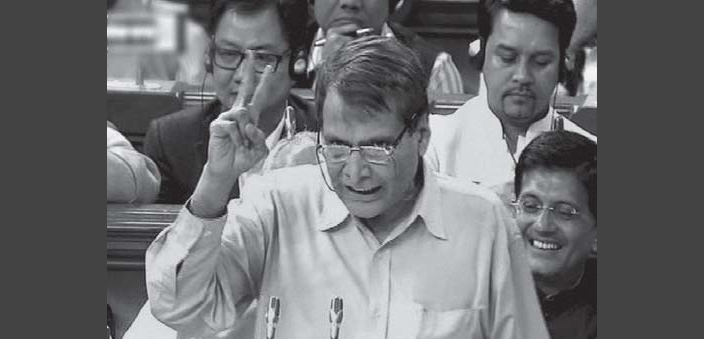The budget announced this year for the Indian Railways has been cheered as one that is not obviously populist, and one that promises improvements in capacity, quality and safety. Let’s briefly analyse the budget to appreciate how well the cheers are deserved.
Before we look at the numbers, a word about the nature of Indian Railways. The railway budget is a statement of revenue of about two lakh crore, which only just covers the costs incurred to earn this money. The numbers of revenue and expenditure of the last few years are: (See Table1 below)
| (Table 1) (all figures in crore) | 2011-12 | 2012-13 | 2013-14 | 2014-15 | 2015-16(proposed) |
|---|---|---|---|---|---|
| Revenue (receipts) | 1,06,245 | 1,26,180 | 1,43,214 | 1,63,450 | 1,88,557 |
| Expenditure | 99,464 | 1,12,565 | 1,31,465 | 1,46,998 | 1,63,480 |
| Surplus | 1,126 | 8,226 | 3,740 | 7,278 | 14,226 |
(figures are from published railway documents)
A large part of the expenditure, largely staff salary and cost of basic maintenance, is fixed, as these items do not change with the level of traffic. The variable component, fuel being the most important, is the smaller part of the total costs. The result is that at a given level of fare and freight, an increase in traffic results in extra revenue but there is only a small increase in costs. On the other hand, a small drop in traffic leads to plunging revenue, but there is only small savings in costs. The key element of the budget, which is, whether income would meet costs, hence depends sensitively on the level of traffic.
It is in this context that we should view the progress of the levels of traffic, which is as follows: (See Table 2) We can see that in the last four years, the goods loading has risen between 39 and 49 million tonnes each year.
But in 2015-16, an increase by 85 million tones is proposed. As for passengers, there has been a falling trend in the last two years, which is proposed to be reversed, to effect healthy 251 million passenger increase in the coming year.
It is on the basis of this proposed increase in traffic that the ambitious growth plan, which is to be funded through borrowing, which would be serviced by internal fund generation, largely depends. But even if the rate of growth of the economy accelerates as it is being said that it will, or the coal and energy sectors open up, it is not clear that about twice the growth in railway goods traffic, as compared to present levels, will happen in the short term.
| (Table 1) (all figures in crore) | 2011-12 | 2012-13 | 2013-14 | 2014-15 | 2015-16(proposed) |
|---|---|---|---|---|---|
| Tonnes loaded (goods) | 969 | 1008 (ie.+ 39) | 1052 (ie. +44) | 1101 (ie.+49) | 1186 (ie,+85) |
| Tonnes kilometers | 6,67,607 | 6,91,658 | 6,65,810 | 6,88,500 | 7,42,691 |
| Goods earnings (crore) | 69,548 | 82,263 | 93,906 | 1,06,927 | 1,21,231 |
| Rs. per tonne km. | 1.04 | 1.19 | 1.41 | 1.55 | 1.63 |
| Number of passengers | 8,224 (ie,197) | 8,421 (ie,-24) | 8397 (ie,-47) | 8350 (ie, +251) | 8601 |
| Passenger kilometers | 1,046,522 | 1,098,103 | 1,158,743 | 1,117,419 | 1,184,465 |
| Passenger earnings (cr.) | 28,246 | 31,323 | 36,632 | 43,002 | 43,002 |
| Rs. per passenger km. | 0.27 | 0.28 | 0.32 | 0.38 | 0.42 |
| Rs. per Pkm/Tkm. ratio | 0.26 | 0.23 | 0.23 | 0.24 | 0.26 |
(figures are from published railway documents)
As passenger traffic accounts for less than half the earnings, even with the rise in numbers of passengers estimated, the traffic that counts is goods traffic. While there is a proposed increase in loading, the published railway documents say that the lead, or the average distance the goods are carried, is planned at 626 km, which is the same as last year and less than previous years. The higher revenue is then to come mainly from the proposed higher loading and the increase in freight rates, which is also substantial, increasing the earning from each tonne kilometer carried from Rs. 1.55 to Rs. 1.63.
Freight rates v/s passenger fares
This brings us to the question of freight rates and passenger fares. The freight rates in India, when compared with rates in other countries on the basis of ‘purchasing power parity’, is among the highest. As the railways are infrastructure for movement of raw material and finished goods to markets, high freight cost certainly affects international competitiveness, which in turn discourages investment in India.
This is especially true when we see that the freight traffic in India bears much of the costs that should be charged to passenger traffic. Continuously over several years, passenger fares have remained substantially unchanged, while freight rates have seen increases, just to make ends meet, every year. A comparison of the ratio of the fare per passenger kilometer and the freight rate per tonne kilometer, in different countries, is revealing. The last row in Table 2 shows this ratio, and we can see that it is almost unchanged, around 25%, since years. The world over, the ratio is at least 85% and in some cases, it is 125%, which means the cost to passengers is quite high, compared to freight rates. In places like this, no doubt, the quality of passenger service, in terms of comfort, cleanliness and speed, is far higher than what the second class passenger enjoys in India. But the great difference in the differential against freight rates indicates that in these places there is real allocation of the cost of passenger comforts to passenger traffic, rather than load the costs on to freight. It is reasonable and predictable pricing of railway freight that would give industry the confidence to make investments needed to rely more on the railways.
The last time an attempt was made to raise passenger fares, the move was stalled by pressures from the political coalition. And then there was the positive step of linking fares\ and rates to diesel prices, a laudable move that has not proved immediately relevant, on account of the dip in oil prices. But this year, the government, which is in a commanding position, had an opportunity to bring the element of rationality into passenger fares, and spare the burden on freight. But it looks like the opportunity to show the world that it means business has been passed up. In fact, the minister has stated publicly (and newspapers have reported) that passenger fares have been left untouched, although the published figures of the passenger kilometers and passenger earnings (last columns in the table) show that the earning per passenger Km has risen from 38 paise to 42 paise. This is some increase, at least, but the comparison with freight has scarcely improved, as freight rates have also gone up.
What will power the proposed investment?
The budget also proposes high levels of investments, in the coming year and the following years. The investments are sought to be funded by pension funds and banks, apart from private participation. Just as in the expectation of higher traffic, why such lending or investment is likely to happen has not been stated. The proposed investment of about Rs. eight lakh crore would call for an annual surplus of nearly one lakh crore to service. The present level of surplus is far below this figure and the tenor of the budget is one of adding amenities, which would involve costs. Unless there is a clear indication of where operating surplus, to meet cost of borrowings will come from, only government guarantees can bring funds into the system. And even if the funds were to be arranged, the fact of the matter is that there is short supply of materials and agencies to execute work. Even the present levels of provision for work like road over-bridges or subways, which concern safety, are not being fully consumed, for various reasons.
The other avenue mentioned is of Private Public Partnership (PPP). Although work financed in this way is also executed by the railway, PPP does bring in an element of private dynamism, apart from funds. But the experience has been that it is with plum, profitable projects, where the partner makes large returns that private parties are willing to associate. This need not necessarily be a deterrent, in the case of projects that will add substantial value, but the system of entering into PPPs needs to be through transparent bidding, and may still end up as cases where private parties benefit by embarrassing windfalls.


